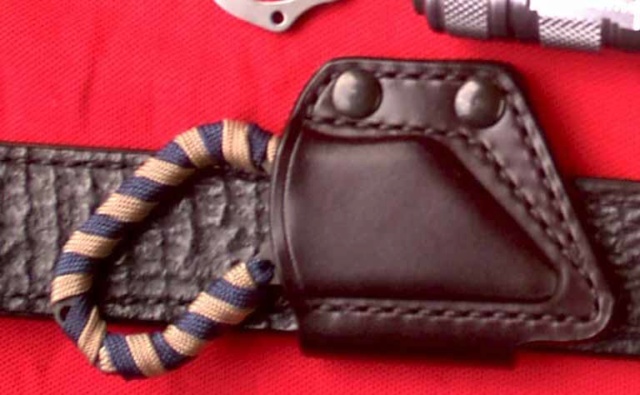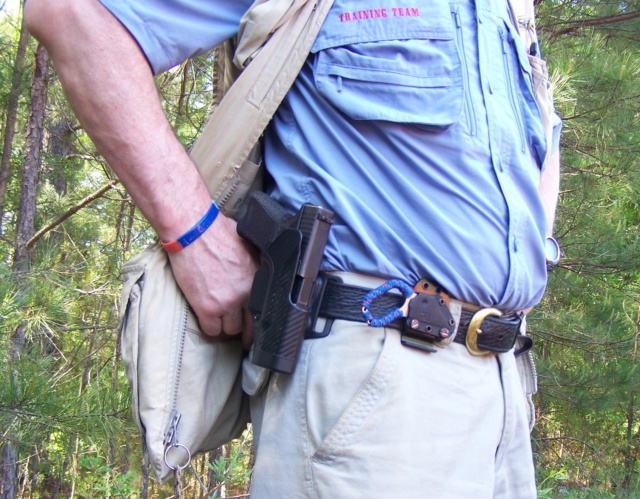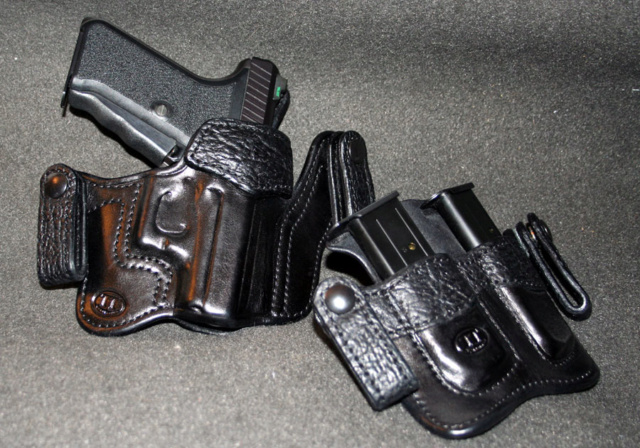I'm placing some previous articles here on the forum.
EnjoyTHE BELT HOLSTER
By
DENNIS MARTIN

Before discussing holster options, we must consider the belt. It’s no use buying a top-line pistol, housing it in the best holster you can afford, and then hanging it on a cheap, flimsy belt. The belt is an essential component of the weapon carriage system.
Again, in this article, we are assuming that the bodyguard is working for a diplomatic or executive personage, who requires discreet protection, so the equipment must blend in with business attire. Leather is still the choice for a discreet, but opulent look. Avoid belts with decorative stitching, or, embossing. A plain black belt fits in best.
At a minimum the BG will be carrying his pistol, spare ammunition, radio and a flashlight, so the belt must be sturdy enough to support this weight without discomfort. We recommend a double-thickness belt, cut on a contour. This conforms to the body and adds structural strength. I’d suggest a width of either 1.5” or 1.25”. Don’t go wider than 1.5 unless you’re working in Texas; and don’t go narrower than 1.25 unless you want to spend the shift feeling cut in two. By the way, you can use a narrow 1” belt for off duty use, if you carry a lightweight pistol and one spare mag.

Ensure that the buckle fits in with the VIP image. Don’t use a police or military commemorative buckle, it’s a real giveaway. Some BGs take a buckle from a Gucci type belt, and use it on their carry belt.
For a Tuxedo, which doesn’t usually have a belt, we designed a buckleless Velcro belt, which Price Western produced for us.

It blended in well, allowing the carriage of essential kit while in evening suit, and remains on the PW product list.
My personal preference in a belt is the Horsehide designs from Kramer Leather.
 [My Kramer Horsehide belt with SIG]
[My Kramer Horsehide belt with SIG]Horsehide is superior to cowhide, and Greg Kramer’s belts are built to last a lifetime. A particular favourite is the Sharkskin faced belt he made for me. This was requested by members of a Tier-one military unit, who spend a lot of time in the water. This belt is super-tough, yet still blends in to any diplomatic occasion.
 [My Kramer Sharkskin belt, here with a Hideaway knife]THE BELT HOLSTER
[My Kramer Sharkskin belt, here with a Hideaway knife]THE BELT HOLSTER
POSITIONS
If we think of the waist as a clock, then there are various positions where the holster can be located, each with their own access characteristics
APPENDIX: At about 1-o’clock is the Appendix position. Famed holster maker Bruce Nelson favoured this carriage mode, when working as an undercover narcotics agent. He would adopt what he called a “hippy slouch” with his thumbs tucked inside the front waistband, mere inches from the concealed autopistol. The pistol lies in the natural groove of the leg/belly joint, as conceals well.

We have discussed this method of carriage
hereSIDE: At 3-o’clock is the Side position. Concealment isn’t as good as the Appendix, because the holster is on the prominence of the hip. However, it’s a good position for a uniform officer to carry his off-duty weapon, as the position is similar.
 [Kramer Sideholster, with kit]
[Kramer Sideholster, with kit]KIDNEY: Going further round the clock we have the Kidney carry at about 5-o’clock. The weapon snuggles into the natural hollow here and conceals very well. This was the location favoured by FBI agents for many years.
 [Bodyguard Course members]
[Bodyguard Course members]CENTRE-OF-BACK: Opposite the buckle at the Centre-of-the-back is another position. Andy Arratoonian designed his Skyway Special for aviation security personnel, and I tried it for about a year. The advantages of this position are that you can secure a good grip without raising the shoulder, it’s a very natural draw action. Also, it conceals well under jackets which have side vents that tend to expose a Kidney carried weapon.

On the other hand, access time is a bit slower, as the hands have to reach back further and the weapon has to travel a bit further up into the firing grip. Not a massive drawback, but when shooting qualification tests with tight time limits it can make the difference between pass and fail.
The biggest drawback, however, is the fact that you are carrying a solid metal object across your spine, making a fall potentially crippling.
CROSSDRAW: On the opposite side of the body, at about 10-o’clock is the Crossdraw. This is a good position for guys with a bodybuilder physique. Large pecs allow the jacket to hang with a clearance gap, and the flat gut allows the weapon to be hidden there.
 [Den using Crossdraw on vehicle convoy in Rhodesia]
[Den using Crossdraw on vehicle convoy in Rhodesia]Although I used a Bucheimer crossdraw for my first pistol, I never really found it to work for me. The cross-body draw action requires gross lateral movement, whereas modern technique emphasises bringing the weapon up through the vertical plane of the target.
 Den with S&W Mod 19 in Bucheimer semi-shoulder holster]CONCEALEMENT
Den with S&W Mod 19 in Bucheimer semi-shoulder holster]CONCEALEMENTA bodyguard wearing a normal suit jacket will keep it unfastened, to allow immediate access to the weapon, the jacket hangs open, exposing the buckle area, and as you move the jacket shifts allowing glimpses of the Appendix and Crossdraw areas. For this reason I don’t recommend these positions, preferring the Kidney, or, Side location instead.
 [A holster can be a work of art, as well as a practical, life-saving device; as shown by this beautiful example from the late Lou Alessi]
[A holster can be a work of art, as well as a practical, life-saving device; as shown by this beautiful example from the late Lou Alessi]OPTIONS
There are three options for the belt/ holster interface:
ON THE BELT
BETWEEN BELT AND BODY
INTERNAL FIT
The “between belt and body” holster, typified by the Sparks Mirage, offers good concealment, as the butt tucks in really well. The downside is that the belt has to be long enough to encompass the added bulk as it goes around the weapon.

The “internal fit” holster is discussed in detail in another article in this series.
In this article we’ll discuss the “On the belt” holster.
The key to pistol skill is consistency. The draw action should be a programmed, repeatable action. In order to promote this, there are several aspects of the belt holster design to consider.
ATTACHMENT LOOP
In the past many holsters had a narrow belt loop, allowing the weapon to flop around on the belt, destroying any hope of a consistent initial access. Today, all the top holster makers offer various options which securely affix the holster to the belt, producing a covert-carriage system which supports the reactive use of the weapon.

The first option is the full-width belt loop. This is usually formed by cutting the holster shape with a large upper flange, then bending this upper part of the rig back, heavily stitching it in place, to form a sturdy tunnel loop.
A designer called Roy Baker came up with the next option.

The Pancake Holster is built with a large area surrounding the holster body. Slots are cut into this border area, allowing both a very positive locking to the belt, but also multiple rake angles, allowing the holster to be positioned in several locations on the belt.
Another type offers a rigid loop, plus a slot. This arrangement allows the holster to straddle a trouser belt-loop, providing stability on the belt; while also giving terrific concealment.
ACCESS
We need to be able to gain a full initial grip on the pistol, to start the firing stroke process. A belt holster allows more “set out” than an internal-fit holster, meaning that the butt is a bit further from the body, allowing the hand to gain the grip easier. Another point, is that the on-belt holster works better with covert body armour than the internal.
SECURITY
A prime requisite of the holster is to retain the weapon against loss during violent activity, including close-quarter fighting. The first thing to note is that the holster must exactly fit the weapon. “One size fits all” holsters are death-traps. A well made holster will afford a degree of friction which may well be enough to retain the pistol. However, there are a couple of other options.
Milt Sparks pioneered the adjustable tension concept. A wedge of leather, or, rubber is screwed up against the pistol within the holster. As the holster wears with age the level of tension can be adjusted.
An alternative is a securing strap. The best of these is the Thumb-break, which is unsnapped instantly during the draw action.
 [This British product from PWL has the proven thumb-break]
[This British product from PWL has the proven thumb-break]Another option is the Draw-break, which fastens in such a way as to be released as the pistol is drawn upwards out of the rig.
 [Draw-break from Allessi]
[Draw-break from Allessi]One such holster was made for a Canadian police department who carried the Heckler & Koch P7. This weapon has a striker which rises as the squeeze-cocker on the grip is activated. The holster was built with a snap released by the striker. It wasn’t long before experts pointed out the danger of such a system and the holster was discontinued.
DISCREET CARRIAGEWhen wearing a suit, you must match the type of holster with the vents. A jacket with side vents will allow “flashing” of a weapon carried in the kidney position. Better to choose a garment with a centre vent.
 [British Royal Bodyguard]
[British Royal Bodyguard]Once the working bodyguard has spent the money to ensure his pistol is carried discreetly and securely, he must then invest the time to integrate the equipment into his training and response process.
COPYRIGHT 2009: :copyright: D. MARTIN 